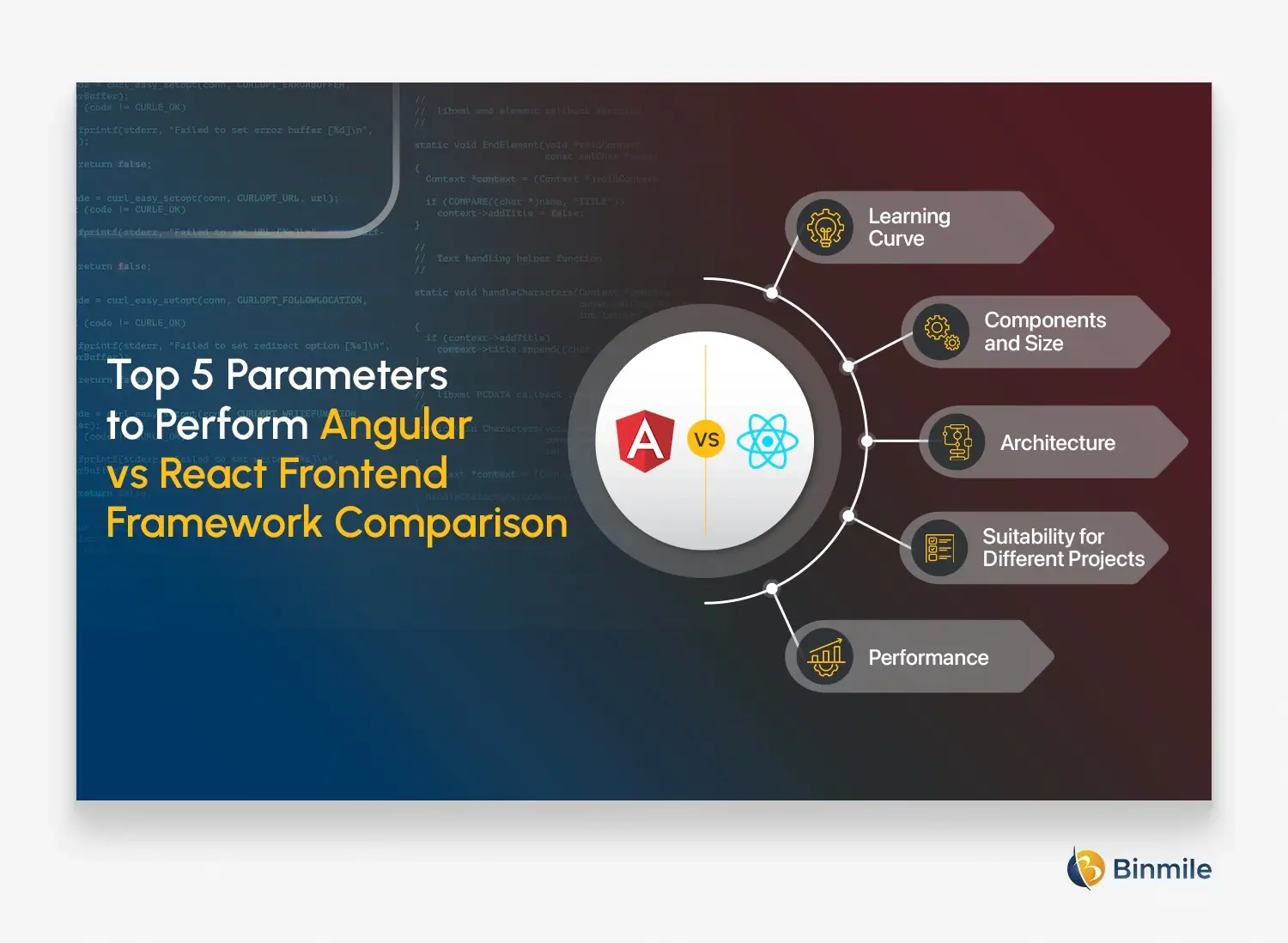For the last few years, web apps have been trending worldwide, even more so than mobile apps, for a reason. Web apps don’t require users to download the application as in the case of native apps. They provide easy access while eliminating the need for end-user maintenance and storage capacity.
What else?
Web applications receive security and software updates automatically, which keeps them up-to-date and free of security breaches. But have you ever thought about how a web application is created? Well, Angular and ReactJS are two popular tools that are used for modern web application development. Now, how do you know which is most suitable for your project and why? To get a deep understanding of Angular vs React Frontend Framework, or Javascript React vs Angular, all you need to do is go through this piece of content thoroughly:
What is React?
React is a front-end JavaScript library that lets you develop user interfaces using reusable UI components. This particular framework uses server-side rendering to offer a flexible and performance-oriented solution. It also enables developers to design seamless UX and complicated UI according to a top React Native app development company. Since React features the “Learn Once, Write Anywhere” approach, it has become the optimum choice for developers to create quick and scalable applications. In fact, as per a leading market analysis tool maker, 41,465,772 websites are powered by React, and an additional 8,396,297 sites used React historically.
What are the Key Features of ReactJS?
- Making the most of declarative views facilitates debugging.
- Easy migration between multiple variants
- More predictable and reusable code
- Decreased development time and increased developer’s productivity
- Appropriate for mobile development and using React Native
What is Angular?
Angular is an open-source JavaScript front-end framework created and handled by the Angular team of Google. It is the most famous client-side framework that comes in handy in building scalable and high-performing mobile and web applications by tapping HTML, CSS, and TypeScript. The most recent version of Angular is Angular 13 which provides enterprise-level web app development solutions per a top Angular development company. According to the finest lead generation tool maker out there, 350,755 live websites are using Angular at the moment and an additional 246,724 used Angular historically.
What are the Key Features of Angular?
- Simple to develop, manage, test, and update
- Support for views irrespective of browser-side rendering
- Server-side rendering takes place swiftly
- Built-in functionalities include Rxjs and AngularCLI
- Robust encapsulation and a proper application framework
Top 5 Parameters to Perform Angular vs React Frontend Framework Comparison

1. Learning Curve
- Angular: Using its Model-View-Controller architecture and TypeScript, Angular provides a structured approach which leads to a steeper learning curve for users not aware of such concepts.
- React: On the other hand, the frontend framework for web development like React uses a component-based architecture and takes advantage of JavaScript, making it effortless to understand, especially for people with a robust foundation in JavaScript.
2. Components and Size
- Angular: When it comes to the Angular vs React frontend framework comparison, you must know that Angular works on a real Document Object Model and follows the MVC pattern. Besides that, this framework follows bidirectional data flow and is large (92KB) compared to React.
- React: On the flip side, React works on a virtual Document Object Model, which is a lightweight version of a real DOM. It follows unidirectional data flow and the size of React (46KB) is smaller than Angular.
3. Architecture
- Angular: It performs a clear separation of concerns with the help of the MVC pattern, fostering well-organized code and simplifying maintenance for large-scale projects.
- React: It taps a component-based architecture, where reusable components contain UI and functionality. This method promotes flexibility and quick UI development, according to top app development companies.
4. Suitability for Different Projects
- Angular: The strong structure and data binding features of Angular help in creating complicated single-page applications and enterprise-level web applications that require scalability and maintainability.
- React: ReactJS excels in developing dynamic UI with frequently changing data. Its component-based architecture fosters modularity and reusability, making it highly suitable for interactive web functionalities and complicated UI elements when it comes to Angular vs React frontend framework comparison.
5. Performance
Coming to the performance aspect, you will be glad to know that both Angular and React are optimized for performance.
- Angular: Likely to shine in complicated single-page applications with ahead-of-time compilation and granular change identification.
- React: Slightly faster for simple applications because of the smaller bundle size and virtual Document Object Model.
Therefore, the experts of top web app development companies suggest focusing on the developer’s experience and project needs when selecting a suitable framework. Because performance difference is almost negligible for a large number of web applications.
Also Read: Front-end apps with ReactJS and ViteJS
5 Use Cases of Angular vs React Frontend Framework That You Must Understand
1. Large Enterprise Application (Angular)
Developing a complicated web application for an organization, such as a Customer Relationship Management (CRM) system or an internal dashboard needs a strong framework like Angular. Its opinionated structure and built-in functionalities, like services, modules, and dependency injection, offer a powerful foundation to handle large-scale projects. The two-way data binding and powerful CLI (Command Line Interface) features of this framework facilitate development tasks, while its TypeScript support makes sure of type safety and improved code maintainability. Above all, the scalable ability of Angular makes it the best choice for accommodating growing business needs and managing complicated data flows when it comes to Angular vs React frontend framework comparison.
2. Social Media Application (React)
To build a social media platform, having an excellent framework at your disposal is necessary that manage real-time updates and user interactions smoothly like ReactJS development services. The digital DOM of React reconciles UI changes effectively, making sure of a seamless and responsive experience in dynamic apps, like social media platforms. Using the component-based architecture of React, software developers can develop reusable UI components for functionalities, like:
- News feeds
- Notification
- Messaging systems
3. eCommerce Platform (React)
Designing a dynamic and user-centric online store requires a framework like React, which is globally popular for its flexibility and component-centric architecture. The declarative approach of React enables developers to put UI elements into reusable components, simplifying the development of customizable and interactive shopping experiences. One of the functionalities, like React Hook, is among the best benefits of ReactJS, which allows state management and side-effect handling, which is important for implementing functionalities, such as seamless product filtering and interactive add-to-cart actions.
4. Single-Page Application with Offline Functionality (Angular)
Creating a complicated Single-Page Application that stays functional even without internet connectivity demands a framework like the Angular 12 version, which provides functionalities for offline support. The service worker support of Angular allows development professionals to implement Progressive Web App (PWA) features, like caching resources and managing network requests, making sure of a smooth user experience even in offline mode.
5. Progressive Web App (Both)
Building a web application that looks and feels native and can be installed on the device of users for offline access can be accomplished using both Angular vs React frontend frameworks. Angular provides a structured approach to building progressive web applications, making the most of features, such as service workers and Angular Universal for server-side rendering to improve performance and reliability. On the other side, React offers flexibility in embracing PWA features, enabling developers to pick from a wide range of libraries and tools, like Workbox for service worker management and Next.js for server-side rendering. In that case, it doesn’t matter whether you prefer Angular’s holistic ecosystem or React’s flexibility, both frameworks allow progressive web application development that offers a native-like experience to users across various devices.
Know the Difference: React JS vs Angular vs Vue JS
In a Nutshell
The competition between Angular vs React frontend frameworks isn’t a no-brainer. Going with the best choice among both depends specifically on your project requirements. Wondering how? Well, if you pay attention to structure, scalability, and maintainability for complicated apps, Angular is the one that might fit your bill. However, if flexibility, quick UI development, and a massive community of users are your top concerns, ReactJS could tick all the right boxes. Irrespective of your decision, both Angular and ReactJS are feature-rich tools for creating excellent web applications as per top web app development companies.
Frequently Asked Questions
Angular is a comprehensive framework offering a robust structure for building dynamic web applications, with built-in features like dependency injection and two-way data binding. ReactJS, on the other hand, is a lightweight library focused on creating fast and interactive user interfaces, leveraging a component-based architecture and virtual DOM for performance.
Choose Angular for large-scale, feature-rich applications requiring a complete ecosystem, and ReactJS for flexible, high-performance projects with simpler integration needs. The decision often depends on your project’s complexity and your team’s expertise.
Both Angular and React are excellent choices for frontend development, but they cater to different needs. Angular is a full-fledged framework with built-in tools for complex, large-scale applications. React is a flexible library focused on building fast, interactive user interfaces, ideal for projects requiring high performance and custom setups.
Choose Angular for enterprise-level apps and React for lightweight, component-driven projects. The decision depends on your project requirements and your team’s familiarity with these technologies.
The cost implications of using Angular vs. React depend on factors like project complexity, development time, and resource availability. Angular may have higher initial costs due to its steep learning curve and more comprehensive structure, but it can save costs in large-scale projects by offering an all-in-one solution. React’s modular nature and vast ecosystem allow for flexibility but might require additional third-party tools, potentially increasing integration costs. Additionally, the availability of experienced developers for either technology can influence costs.










